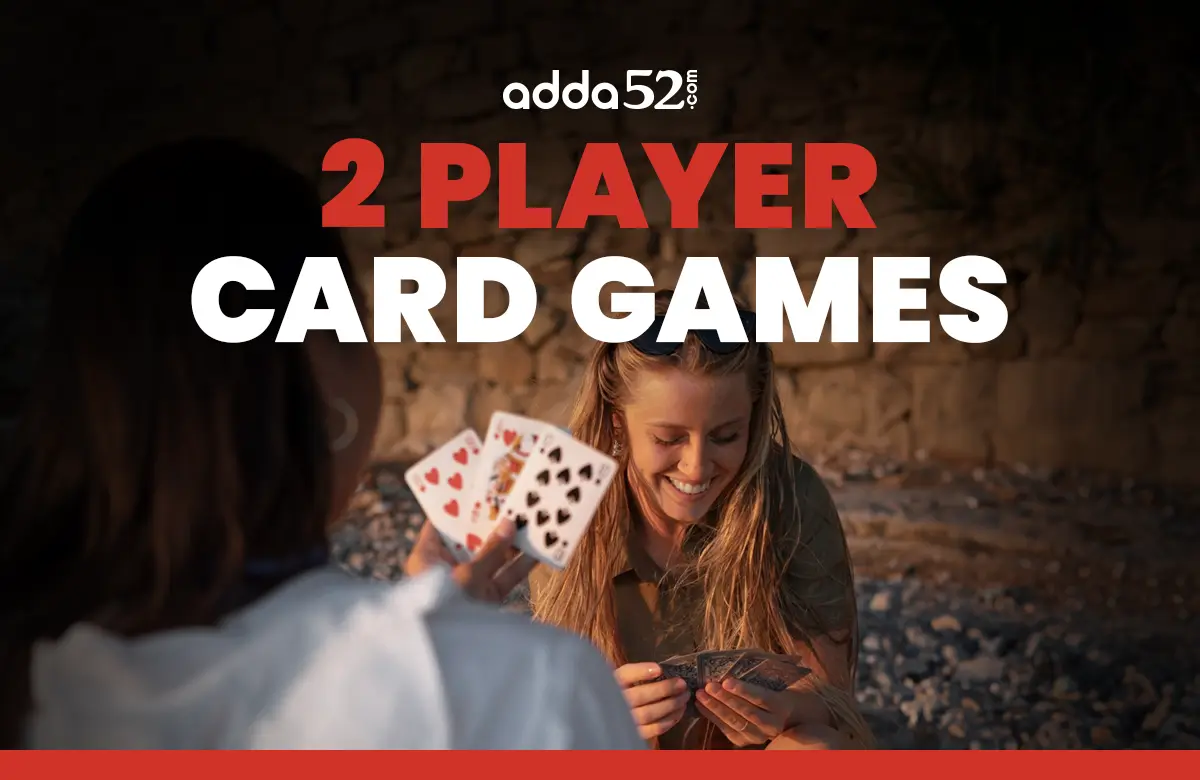
Introduction
Card games, particularly two-player card games, are a favourite pastime in social gatherings. They offer a blend of strategy, skill, and competition. Be it Gin Rummy or 7 Wonders Duel, these 2-player games are endless fun for pairs.
Are you looking for a fun way to pass the time or seeking a bit of friendly competition? Two-player card games offer the perfect solution!
Find the right game that suits your interests and skill set. We have compiled an extensive list of the best two-player card games, which offer hours of entertainment with minimal setup requirements.
Have a look and pick your game!
List of the best 2 player card games
Here are some of the most acclaimed card games for two people:
Poker
Poker is a popular card game with several variants, such as Texas Hold'em and Omaha. In most cases, it involves multiple participants; however, 'Heads-Up' poker also permits a tailored two-player edition.
Basic Rules of Poker
Objective: You can acquire chips by displaying the best hand during the showdown or compelling all other players to fold.
Setup: Using a standard deck of 52 cards, the game deals two hole cards to each player and positions five community cards face-up on the board.
How to Play
- Pre-Flop: Players are dealt two hole cards. Betting starts with the player to the left of the big blind.
- Flop: Three community cards are dealt face-up. Another round of betting ensues.
- Turn: A fourth community card is dealt. Another betting round follows.
- River: The fifth and final community card is dealt. The final round of betting takes place.
- Showdown: If two or more players remain after the final betting round, hands are revealed, and the best hand wins the pot.
Popular Variations
- Texas Hold'em: Players receive two hole cards each and can choose to combine them with the five community cards, allowing for optimal value in creating their card hands.
- Omaha: Each player gets four hole cards, and they must use exactly two of them, along with three of the five community cards, to make the best hand.
Rummy Game
In India, Rummy stands out as a top-notch card game for two players thanks to its straightforward rules that anyone can follow. The objective is to create sets and sequences using the cards distributed among the participants.
Basic Rules
Objective: Form valid sets and sequences with the dealt cards and declare.
Setup: Typically played with two decks of cards, including jokers. Each player is dealt 13 cards.
How to Play
- Drawing and Discarding: Players draw a card from either the closed deck or the open pile and discard a card to the open pile.
- Forming Sets and Sequences: Every player receives a couple of hole cards and can employ any combination of their personal and five communal ones, aiming for high-value card hands.
- Declaration: When a player forms valid sets and sequences, they declare. The cards are then shown to the opponent for validation.
Popular Variations
- Points Rummy: Players play for points, and the game continues until a certain point threshold is reached.
- Pool Rummy: The game involves players adding to a shared pool, and it only concludes once one player stays within the established points threshold (for example - 101 or 201 points).
- Deals Rummy: Played for a fixed number of deals, and the player with the highest points at the end wins.
Go Fish
Deck: Standard 52-card deck.
Objective: Collect sets of four cards of the same rank.
How to Play
- Each player is dealt 7 cards.
- Players ask the opponent for specific ranks of cards they already hold.
- If the opponent has the requested card, they must hand it over; if not, the asking player draws from the deck.
- When a player collects four cards, he lays it down.
Winning: The player with the most sets at the end wins.
Crazy Eights
Deck: Standard 52-card deck.
Objective: Be the first to get rid of all your cards.
How to Play
- Each player is dealt 5 cards.
- Players must take turns playing a card that matches either the rank or suit of the topmost discarded card.
- Eights are wild and can be played at any time.
- If a player cannot play a card, they draw from the stockpile
Winning: The first player to empty his hand wins.
Canasta
Deck: Two standard 52-card decks plus four jokers (108 cards total).
Objective: Form melds of seven cards of the same rank (called Canastas) and score points.
How to Play
- Each player is dealt 15 cards. Players draw two cards and discard one on their turn.
- Players can lay down melds of three or more cards. A meld of seven cards of the same rank is a Canasta.
Winning: The game concludes when a player lays down all his cards. The individual with the highest number of points emerges as the victor.
Klondike Solitaire
Deck: Standard 52-card deck.
Objective: Build four foundation piles from Ace to King in each suit faster than your opponent.
How to Play
- Each player sets up his own Klondike layout.
- Players play simultaneously, drawing and moving cards to the tableau or foundations.
- Players can only build on their foundations.
Winning: The first player to build all their cards to the foundations wins.
Bluff Card Game
Deck: Standard 52-card deck.
Objective: To get rid of all your cards by lying about the cards you are playing.
How to Play
- Cards are distributed evenly among players.
- Players place cards face-down and claim them to be of a certain rank.
- Another player can challenge the claim; the liar takes the prize if it is false.
Winning: The first player who gets rid of all his cards wins.
Andar Bahar Game
Deck: Standard 52-card deck.
Objective: The task is to predict which pile, 'Andar' or 'Bahar', will obtain a card matching the value of the initially drawn card before the other.
How to Play
- The dealer draws one card from the deck and places it face-up in the middle.
- Players bet whether the next matching card will appear in the 'Andar' (inside) or 'Bahar' (outside) pile.
- The dealer deals cards alternately to the 'Andar' and 'Bahar' piles until a card matching the initial card's value appears.
Winning: Players who bet on the correct pile win.
21 Puzzle Card Game
Deck: A standard 52-card deck.
Objective: The objective is to place the cards in the columns so that the value adds up to 21 or less.
How to Play
The game begins when you match with an opponent. Both players get the same board, divided into five columns and a stack of cards at the bottom of the screen. The game’s objective is to place the cards in the column so that the value of the cards adds up to 21 or less. If it goes beyond 21, you lose a life; if you lose five lives, you lose the game. You can afford to lose five lives. The game continues until the time goes off. Once the time ends, the player with the highest score wins.
SlapJack
Deck: A standard 52-card deck.
Objective: To win all the cards by slapping the pile whenever you see the Jack.
How to Play
First, shuffle the deck and distribute it evenly among the players face down. The game moves clockwise, and players take turns playing the top card from their pile on the centre pile. If you see the Jack, you must slap the pile quickly. The first player to slap wins the entire deck.
Cribbage
Deck: A standard 52-card deck.
Objective: The objective is to be the first player to score 121 by forming card combinations.
How to play
After shuffling, each player gets six cards. Each player discards two cards face down into a separate pile called the crib. The dealer then cuts the deck and flips the top card. Players then take turns and play one card at a time, adding up their cumulative total but not exceeding 31. Once all the cards have been played, you count the pints in your hand. The player with 121 points wins.
Speed
Deck: A standard 52-card deck (Removed Joker).
Objective: Be the first player to get rid of all your cards.
How to play
Each player gets 5 cards in their hand and 15 in a draw pile. Two face-up piles are placed in the centre, with a single card face-up next to the crib. Each player flips one card of the two sets simultaneously and discards the card in their hand by playing the next highest or lowest card.
Old Maid
Deck: A standard 52-card deck (Remove one Queen).
Objective: Avoid being the Old Maid, a plate with a single unpaired card.
How to play
After shuffling, the cards are dealt evenly among the players. You will first remove all the pairs in your hand. In each turn, you draw one card; if it forms a pair, you will discard it or keep it. The game continues until all pairs are discarded, and a player is left with the Old Maid card.
Kings in the Corner
Deck: A standard 52-card deck.
Objective: Be the first player to get rid of all your cards by playing them in descending order.
How to play
The game begins with each player getting 10 cards, and a balance of cards is laid out on the table. To set up a balanced deck, the deck of cards is set face down in the middle for a stockpile, and one card is placed face up. Once the balanced deck is set up, you place cards on the balanced pile in descending order. The Kings are placed in the four corners as separate foundation piles. You can move an entire pile if you follow the descending order.
War
Deck: A standard 52-card deck.
Objective: Win all the cards by playing the highest-ranked card in a series of faceoffs.
How to play
The card is dealt evenly face-down to both players, who flip their top cards simultaneously. The higher card wins, and the winner takes both cards. If there’s a tie, the war happens, and each player places three more cards face down and one face up. The highest face-up wins all the cards.
Frequently Asked Questions
What are two-player card games?
Card games for two players utilise a conventional deck of cards and typically require elements of strategy, chance, and expertise. These diversions can range from swift-paced gameplay to more complex strategic challenges.
What is the main objective of 2 person card games?
To emerge victorious in two-person card games, one must achieve designated objectives, such as amassing points, forming distinct card compositions, or being the initial player to discard all held cards.
What is ‘Heads-Up’ Poker?
A modified version of the traditional card game, Heads-Up poker is a face-off between two players. Each participant receives his pair of private cards, followed by five community cards that are shared amongst them both. To emerge victorious, one must obtain the highest amount of chips possible by revealing a powerful hand during a showdown or causing the opponent to surrender his cards.
Conclusion
You just need a deck of cards to play a 2-player card game. Most games are available online, where you can play and improve your game. With their easy-to-learn rules and gameplay tactics, these classic games present ample opportunities for players to spend quality time with friends and win mind-blowing rewards.
